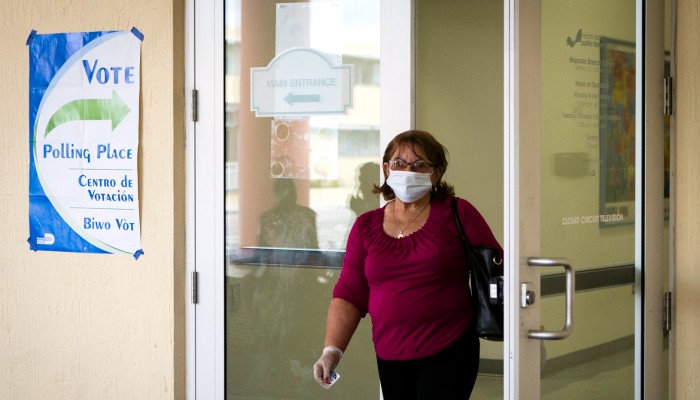The Brennan Center has laid out the critical adjustments that must be made to our voting system to ensure safe and fair elections this November in the midst of the Covid-19 pandemic. Increased access to vote-by-mail is a key part of the plan, as many voters may face quarantine and illness. Safe and healthy polling places are also critical: giving every voter access to a mail ballot option will not replace all polling place voting, and it should not come at the expense of access to polling places. The anticipated shift to large-scale mail voting will put significant strains on our election systems; polling sites serve as a fail-safe to correct any problems that may arise and ensure eligible citizens can vote.
In the ordinary course, new voting procedures typically cause disruptions and problems the first time they are used. This problem will be compounded by the sheer magnitude of the shift to mail-voting, coupled with the chaos and confusion caused by the virus. The reality is that many voters, especially in communities and demographic groups with poor mail access, are used to voting in-person, prefer to do so, and will not be willing or able to vote by mail. Those voters will need safe and healthy in-person voting options this November.
A nationwide, mail only election is not realistic.
The 2020 general election is only seven months away — it is not realistic to expect that every state will be able to fully adopt a vote-by-mail system that is accessible to all voters by then. There are only five states that currently send every voter a vote-at-home ballot (Colorado, Hawaii, Oregon, Utah, and Washington). Only four other states (Arizona, California, Montana, and New Mexico) received a majority of ballots by mail in 2018. In fact, 27 states and the District of Colombia received fewer than 10 percent of votes by mail in 2018.
An all-mail election for those jurisdictions would entail between a 10-fold and 60-fold increase in mail-voting. While it is critical that those jurisdictions afford every voter the opportunity to receive a mail ballot, many jurisdictions may not be able to do so without significant gaps. They also may not be able to handle the administrative load effectively if every voter takes that opportunity. Even states that typically hold their elections primarily by mail offer in-person voting opportunities, though not as much as would be needed in states without a mail-voting culture.
A change of this magnitude will undoubtedly create a lot of confusion and error for voters and election administrators. Mail-voting without polling places would also lead to widespread disenfranchisement. For example, nationwide, over 430,000 mail ballots were rejected in 2018 because of mail delays, minor technical defects, and voter errors, among other reasons. And the impact can hit underrepresented communities hardest: in some states, Black, Latino, Asian, and other minorities have had their vote-by-mail ballots rejected at much higher rates than white voters.
When things go wrong, polling sites provide a necessary fail-safe in mail ballot systems.
As states ramp up vote-by-mail options, polling sites are needed as a back up to address problems with mail voting, so that voters who do not receive their mail ballots or have a problem with their ballots can still vote. Problems are inescapable, both because of the dramatic changes to the voting process this year and because of inevitable errors and glitches in mail-voting systems. Polling sites serve as a critical backup to address these problems and resolve eligibility questions. They may be the only option for most voters who do not receive their mail ballots or experience problems with those ballots.
- Transition glitches: When states roll out new election reforms or systems, they typically experience transition problems. For example, the lines in Los Angeles during the primary were attributed, at least in part, to the roll-out of new voting technology and the introduction of vote centers. The meltdown in the vote-counting process in the Democratic Iowa caucuses was due largely to the use of a new and untested reporting app. The sheer magnitude of the changes required this year to allow for widespread mail-voting will compound the problem. To the extent that glitches in the system prevent voters from obtaining their ballots by mail, polling place voting may be their only option for participating.
- Data errors: Data entry errors — especially as election workers, many of them temporary, are rushing to process voter registration applications and mail ballot applications — could prevent voters from receiving their ballots. Errors as small as a mistyped or transposed number or a “St” instead of an “Ave,” either on a voter’s application or made in the data entry process, could lead to a ballot never arriving at the correct address. In some jurisdictions, the number of errors on existing voter rolls may be especially high. In 2012, the Pew Center on the States found that 1 in 8 voter-registration records in the United States had significant errors.
- Mail-delivery problems: Even when an elections office has a voter’s correct address, her ballot may not reach her on time or at all, through no fault of the voter’s. Even without a pandemic, mail ballots may be lost, delayed, or deemed undeliverable. For example, if a voter’s name is not listed on the mailbox, or the mailbox is full, postal workers may be reluctant to deliver mail there. This is more likely this year as Covid-19 has forced many people into new and temporary living situations. Ordinary mail disruptions will also be greater. Mail delays have increased in recent years. And the pandemic is already straining the postal service. There may also be disruptions to the post office workforce caused by Covid-19. Polling places ensure that voters facing these problems can vote, too.
- Eligibility issues: States ought to relax voter identification or other documentation requirements during the pandemic, as it will be difficult or impossible for voters to obtain identification amidst government office shutdowns. Nonetheless, some states likely will not do so, and there may be circumstances in which certain voters will need to verify their identities. Under some state mail voting systems, voters are required to include a copy of their identification when they return their ballots. Without relaxing those draconian rules, voters without access to copying or printing equipment could be shut out. Polling places not only allow voters to show their identification to an election worker, but they also allow voters who do not have the required ID to take advantage of fail-safe procedures to demonstrate their identities and vote. And voters who do not receive a mail ballot because of eligibility questions can more easily resolve those issues in person at a polling place than by mail.
Some voters cannot, or do not want to, vote by mail.
Many Americans do not have access to reliable mail delivery, and many do not have conventional mailing addresses for ballot delivery. Eliminating polling sites would completely disenfranchise these voters. Ineffective mail service is more common in poor and minority communities as well as in rural communities. Many Native American reservations do not have residential street addresses that are recognized by the postal services, and the residents on those reservations have to rely on P.O. boxes that are far from their homes, often shared with multiple families. Many homeless people also do not have ready access to reliable mail service.
Other voters, who are accustomed to visiting their Election Day polling place to cast a ballot, will be reluctant or even suspicious of casting their vote any other way. This is especially true for Latino, African-American, and younger voters in some states, who use vote-by-mail at lower rates than other voters. For some of these voters, the choice is driven by distrust in the post office. One study found that voters of color were far less likely to trust the post office than white voters. Even in states where vote-by-mail is widely available, a significant number of voters choose to deliver their completed ballots to polling sites, instead of returning them through the mail.
Many essential voter services work best when they are provided at polling places.
For many voters, the services they need to vote privately and independently are available at polling sites and are more challenging to access via mail.
- Voters with disabilities: Voting by mail is difficult or impossible for people with certain visual and dexterity disabilities without substantial assistance. In contrast, specially-designed voting machines available at polling sites allow voters with disabilities to vote privately and independently. Indeed, studies find that the majority of voters with disabilities prefer to vote in-person.
- Voters needing language assistance: More than 16 million Americans rely on the legally mandated bilingual assistance and translated materials they get at polling sites to vote. While it is critical that states provide similarly translated materials by mail, there will undoubtedly be gaps. And, in any event, voters with language assistance needs will not have an election worker proficient in their language in front of them to ask questions unless they go to a polling place.
- Voters needing to register on the day they vote: Voters in 20 states use some form of “Election-Day registration,” which means that a voter can register and vote on the same day. The consensus among political scientists is that turnout in states that have adopted this policy is as much as five percentage points higher than in other states, particularly among young people, people with low incomes, and people of color. The current crisis only elevates the importance of this option, as millions of voters will have difficulty accessing voter registration, and voters displaced by the pandemic will need to register at their new residences. Election Day registration is currently only available in person. If polling places are shut down, many prospective voters will find themselves shut out of the election as a result.
Covid-19 poses an unprecedented challenge to election administration. Expanded access to vote-by-mail is a critical component of any plan to address the crisis, but it cannot be the only component. We do not know what the state of the pandemic will be in November, but states must make every effort to continue to offer meaningful access to in-person voting polling locations that are safe and sanitary.




